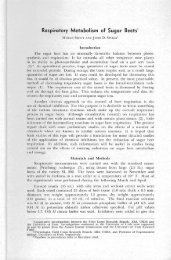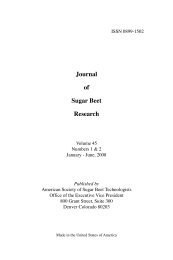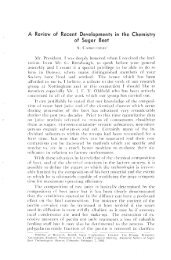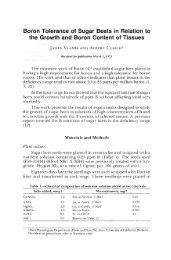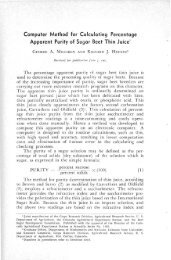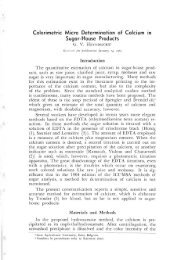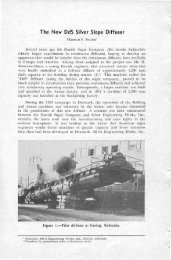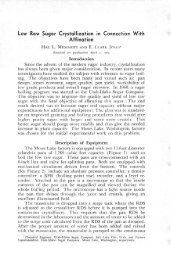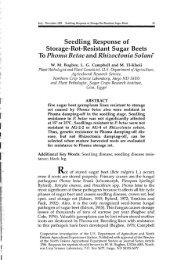Millipore-Antimony Pentachloride Colorimetric Method for the ... - Vol
Millipore-Antimony Pentachloride Colorimetric Method for the ... - Vol
Millipore-Antimony Pentachloride Colorimetric Method for the ... - Vol
Create successful ePaper yourself
Turn your PDF publications into a flip-book with our unique Google optimized e-Paper software.
496 JOURNAL OF THE A. S. S. B. T.<br />
Stansbury and Hoffpau ir (11) retained cane Aoc from an<br />
acidified cane sugar solution on a <strong>Millipore</strong> filter. They eventually<br />
extracted <strong>the</strong> floc from <strong>the</strong> filter <strong>for</strong> fur<strong>the</strong>r analysis. Our<br />
thoughts were directed originally to <strong>the</strong> idea of extracting <strong>the</strong><br />
saponin from <strong>the</strong> Vfillipore filler 'with methanol, and eventually<br />
developing <strong>the</strong> saponin color with cuncentrated sulfuric acid.<br />
This pian was readily abandoned when it became apparent that<br />
<strong>the</strong> Ylillipore filter was dissolved by methanul which in turn gave<br />
a color development with concentrated sulfuric acid.<br />
The VIillipore technical literature (9) indicated that qualitative<br />
spot tests could be per<strong>for</strong>med on <strong>the</strong> :<strong>Millipore</strong> filter surface.<br />
It was noted in <strong>the</strong> :Vlillipore Chemical Resistance Table (9)<br />
that <strong>the</strong> j\li1lipore filter was not affected by chloro<strong>for</strong>m. We<br />
were able to demonstrate that a chloro<strong>for</strong>m solution containing<br />
antimony pentachloride ga ve t he characteristic pink color test<br />
<strong>for</strong> saponin on <strong>the</strong> \ /fillipore filter surface without destroying<br />
<strong>the</strong> filter.<br />
Grab samples of sugar from each of our mills were evaluated<br />
<strong>for</strong> floc and <strong>for</strong> relative saponin content as listed in Table 1.<br />
In <strong>the</strong> American Crystal Sugar Company adaptation of <strong>the</strong><br />
Spreckels' floc method, an acidified 31 Brix sugar solution uf<br />
pH 2.0 with HCI, is bronght to boil and allowed to simmer<br />
<strong>for</strong> 5 minutes. A floc grade, by The Seven-C p grading system,<br />
not exceeding 2 at <strong>the</strong> end of 72 hours is considered to be Bottlers<br />
sugar.<br />
Table 1 points ont <strong>the</strong> excellent agreement of <strong>the</strong> floc method<br />
and of <strong>the</strong> saponin <strong>Millipore</strong>-SbC1 5 method.<br />
The Saponin :\1illipore-SbCI5 test was run on <strong>the</strong>se same<br />
sugars several times by different individuals. Each time <strong>the</strong> resul ts<br />
duplicated those listed in Table 1. By determining <strong>the</strong> relative<br />
saponin contents by <strong>the</strong> <strong>Millipore</strong>-SbCl 5 method (10-15 minutes),<br />
we were able to predict <strong>the</strong> floc per<strong>for</strong>mance (at <strong>the</strong> end of 72<br />
hours) of those sugars.<br />
Table I.-Original evaluation of saponin by <strong>Millipore</strong>-SbCL method.<br />
Floc<br />
Saponi.n by MilJipore-SbCh<br />
Factory grade Rank Color intensity<br />
A 4 Intense Pink<br />
B 4 7 Intense Pink<br />
C 4 7 Intense Pink<br />
I) 2 6 Mildly Pink<br />
E I I Barely Pink<br />
F I Barely Pink<br />
G I Barely Pink<br />
H I Barely Pink<br />
I I Barely Pink
VOL. 15, :\fo. 6, JULY 1969 497<br />
Since a sugar ,,·ith a floc grade no greater than a plus 2 at<br />
<strong>the</strong> end of 72 hours will meet <strong>the</strong> Bottlers standard, such a sugar<br />
should <strong>the</strong>n serve adequately as a control. Thus if <strong>the</strong> developed<br />
saponin color of <strong>the</strong> unknm,vn strike of sugar is less than or<br />
equal to that of <strong>the</strong> control sugar <strong>the</strong>n it is considered to be<br />
floc free and thus acceptable to <strong>the</strong> beverage industry. By running<br />
<strong>the</strong> control at <strong>the</strong> same time or just prior to <strong>the</strong> unknown, <strong>the</strong>n<br />
<strong>the</strong> parameters of <strong>the</strong> test are <strong>the</strong> same <strong>for</strong> <strong>the</strong> control and <strong>the</strong><br />
unknown. Great care should be exercised in selecting <strong>the</strong> control.<br />
It is possible that <strong>the</strong> control may allow some floc sugars<br />
to be graded as floc free sugar by <strong>the</strong> <strong>Millipore</strong>-SbCl 5 method.<br />
Historically we have found this rule o[ thumb, that if a sugar<br />
contains 1 ppm saponin or less it will produce a floc not greater<br />
than a plus 2. Thus if <strong>the</strong> control contains 1 ppm saponin or<br />
less it should reject all floc sugar. This rule of thumb may not<br />
exist <strong>for</strong> all companies, due to <strong>the</strong> purity of <strong>the</strong> saponin standard,<br />
to <strong>the</strong> kind of floc test and to <strong>the</strong> final time of observation of<br />
<strong>the</strong> acidified sugar solution <strong>for</strong> floc grading.<br />
If <strong>the</strong> chemist is satisfied that an appropriate control has been<br />
obtained, <strong>the</strong>n a sufficienL quantity of that lot of sugar should<br />
be set aside.<br />
<strong>Antimony</strong> <strong>Pentachloride</strong> Reagent<br />
The following antimony pentachloride solution (2) after aging<br />
3 to 4 days serves quite adequately <strong>for</strong> producing a pink color<br />
with saponin on a <strong>Millipore</strong> filter:<br />
5 ml SbCl5<br />
95 ml CHCIs<br />
I g SbClg<br />
<strong>Antimony</strong> pentachloride as it appears commercially contains<br />
free chlorine. The free chlorine inhibits <strong>the</strong> saponin-antimony<br />
pentachloride reaction. One gram of antimony trichloride added<br />
to 100 ml of 5% antimony pentachloride-chloro<strong>for</strong>rh solution<br />
will tie up <strong>the</strong> chlorine to make antimony pentachloride. An<br />
excess of antimony trichloride will impede <strong>the</strong> color reaction<br />
of saponin with antimony pentachloride.<br />
<strong>Antimony</strong> pentachloride has great affinity <strong>for</strong> water, thus producing<br />
pyroantimonic acid and hydrochloric acid. High relative<br />
humidities can have a quenching effect on <strong>the</strong> color development<br />
of <strong>the</strong> saponin. Glassware used to prepare <strong>the</strong> antimony pentachloride<br />
reagent can become coated with a residue of pyroantimonic<br />
acid that is practically impossihle to remove. Glass stoppered<br />
bottles containing <strong>the</strong> antimony pentachloride reagent<br />
freeze shut requiring special ef<strong>for</strong>ts to unstopper.<br />
We have found <strong>the</strong> use of glass bottles with Teflon lined<br />
screw caps to be quite successful <strong>for</strong> <strong>the</strong> preparation and storage
VOL. 15, No.6, JULY 1969 499<br />
Procedure:<br />
1. Dissolve 100 gnms of refined beet sugar in 200 ml of 2.0<br />
HC1. (Time: I to 3 minutes)<br />
2. Filter with vacuum through a 1.2 porosity <strong>Millipore</strong> filter.<br />
(I ime: 1 to 2 minutes)<br />
3. Rinse with 100 ml of pH 2.0 IIe1.<br />
(Time: less than 1 minute)<br />
4. Oven dry <strong>Millipore</strong> filter at about 105 ° C.<br />
(Time: 2 to 5 minutes)<br />
5. Apply a drop of 5% SbCl 5 reagent to <strong>Millipore</strong> filter and<br />
to <strong>the</strong> control <strong>Millipore</strong> filter, compare at room temperature<br />
and/ or at warmer temperatures.<br />
Although high relative humidity may impede <strong>the</strong> saponinantimony<br />
pentachloride pink color development at room temperature,<br />
this interference does not occur at temperatures as high<br />
as 105° C. If one is not satisfied with <strong>the</strong> color development,<br />
<strong>the</strong>n he should apply reagent again to unused areas of <strong>the</strong> filters<br />
of <strong>the</strong> control and of <strong>the</strong> unkno'wn and re-evaluate. These NIillipore<br />
filters after evaluation have been retained enclosed as long<br />
as 4 months without any apparent decomposition and have still<br />
given a saponin test with antimony pentachloride reagent.<br />
The <strong>Millipore</strong> SbCl 5 Control <strong>Method</strong> was tested at various<br />
factories this past campaign. The chief chemists provided <strong>the</strong>ir<br />
own control sugars. The results from four different factories are<br />
listed in Table 2.<br />
The chief chemists from <strong>the</strong> four factories were impressed<br />
with <strong>the</strong> method. The chief chemist from D factory was not<br />
able to recheck <strong>the</strong> one sugar which failed <strong>the</strong> <strong>Millipore</strong>-SbCl n<br />
test. He thought that a control sugar with a slightly higher<br />
saponin content would have allowed more actual floc-free sugars<br />
to be graded Aoc free by <strong>the</strong> <strong>Millipore</strong>-SbC1 5 method. His control<br />
sugar was found to contain .8 ppm saponin.<br />
The chief chemist from F factory reported that <strong>the</strong> <strong>Millipore</strong><br />
Sbe!:; method, gTaded as floc-free, 85 to 90% of those strikes of<br />
sugar found to be floc-free at <strong>the</strong> end of 72 hours hy <strong>the</strong> Spreckels'<br />
floc method. He also thought that on several occasions <strong>the</strong><br />
Tahle 2.-Floc test versus <strong>Millipore</strong>-SbClr. control method at {our factories.<br />
No. of<br />
Bottlers sugar<br />
Factory samples Floc test <strong>Millipore</strong>-SbCI,<br />
0 60 37 201<br />
E 30 16 16·<br />
F 60 "85 to 90% of floc test"<br />
G 16 I4 12<br />
10n one occasion floc-free by <strong>Millipore</strong>-SbCb became fl oc sugar by Spreckels' floc<br />
method at <strong>the</strong> end of 72 hours.<br />
, On two occasions floc-free by <strong>Millipore</strong>·SbCb became floc sugar by Spreckels' fl oc<br />
method at <strong>the</strong> enel of 72 hours.
500 ]OUR:-:AL OF TIlE A. S. S. B. T.<br />
lVlillipore-SbCl 5 method graded as floc-free, sugars that became<br />
floc sugar at <strong>the</strong> end of 72 hours by <strong>the</strong> Spreckels' floc method.<br />
It should be pointed out that in <strong>the</strong> original instructions to<br />
<strong>the</strong> chief chemists <strong>the</strong>y were to use pIT 1.0 Hel <strong>for</strong> solution<br />
of <strong>the</strong> 100 grams of sugar <strong>for</strong> testing. A t pH 1.0, partial charring<br />
and brittleness of <strong>the</strong> <strong>Millipore</strong> filter on oven drying, and depressed<br />
color development of <strong>the</strong> saponin-SbC1 5 reaction occurred.<br />
Subsequently it was found that at pH 2.0 <strong>the</strong>se problems disappeared.<br />
The data from D, E and F factories are composed mostly<br />
of pH 1.0 results. The r esults of G factory represent pH 2.0.<br />
It may be that less saponin is filtered out at pH 2.0 than at<br />
ph 1.0; huwever, this should have no bearing on <strong>the</strong> method as<br />
long as <strong>the</strong> control sugar or standards are also made up at pH 2.0.<br />
vVeekly composites of sugar from each of ollr mills ·were<br />
sent to <strong>the</strong> R esearch Laboratory <strong>for</strong> analysis. Table 3 compares<br />
<strong>the</strong> floc test and <strong>the</strong> <strong>Millipore</strong>-SbC 15 method.<br />
The <strong>Millipore</strong>-SbCl 5 method re jected all of <strong>the</strong> floc sugars.<br />
The c.antrol sugar at <strong>the</strong> Research Laboratory contained .8 ppm<br />
saponm.<br />
Saponin MiIlipore-SbCl 5 Quantitative <strong>Method</strong>:<br />
Originally it was n ot possible to quantitate directly <strong>the</strong> saponin<br />
content of beet sugar on <strong>the</strong> <strong>Millipore</strong> filter. The pink color<br />
of <strong>the</strong> saponin from beet sugar was evenly distributed over <strong>the</strong><br />
area of <strong>the</strong> spot on <strong>the</strong> <strong>Millipore</strong> filter surface ·when antimony<br />
pentachloride reagent was applied. This is not <strong>the</strong> case <strong>for</strong><br />
purified saponin obtained from limecake or from sugarbeet skin.<br />
Such saponin is washed out to <strong>the</strong> periphery of <strong>the</strong> spot on<br />
treatment with antimony pentachloride, thus making it impossible<br />
to quantitate. More recently it was found that saponin obtained<br />
from beet sugar m olasses acts similarly to <strong>the</strong> saponin found in<br />
beet sugar, thus allowing <strong>for</strong> direct quantitation on <strong>the</strong> <strong>Millipore</strong><br />
fil ter.<br />
T a ble 3.-Floc test verSuS i\1il1ipore·SbCI5 control method at research laboratory.<br />
Factory<br />
A<br />
B<br />
C<br />
D<br />
E<br />
f<br />
G<br />
H<br />
No. of<br />
samples Floc test<br />
3<br />
13<br />
15<br />
16<br />
16<br />
17<br />
16<br />
15<br />
Bottlers sugar<br />
Total III 66 56<br />
13<br />
7<br />
0<br />
16<br />
16<br />
0<br />
13<br />
<strong>Millipore</strong>-SbCI,<br />
% Acceptable 59.5 50.5<br />
1<br />
13<br />
5<br />
0<br />
13<br />
13<br />
0<br />
II
VOL. 15, :1'\0. G, JULY 1969<br />
501<br />
Beet sugar free of saponin is <strong>for</strong>tified with vanolls levels<br />
of saponin from molasses. Usually .1000 grams saponin are dissolved<br />
in 1 liter of m ethanol. Thus 1 ml of <strong>the</strong> methanol solution<br />
of saponin is added to 100 grams of saponin-free beet sugar<br />
to produce a 1 ppm saponin standard. It is very difficult, if not<br />
impossible, to find refined beet sugar free of any sa ponin. Orig·<br />
inally it was thought that cane sugar could be used <strong>for</strong> preparation<br />
of <strong>the</strong> saponin standards. It 'was found that <strong>the</strong> saponin<br />
added to cane sugar ,vas partially or completely masked on color<br />
development with antimony pentachloride.<br />
We were able to locate a strike of sugar that had no more<br />
than, and possibly much less than, .1 ppm saponin. This lot of<br />
sugar is being used <strong>for</strong> preparation of saponin standards. Previo us<br />
to finding this lot of sugar, we simply <strong>for</strong>tified with saponin <strong>the</strong><br />
filtrate of an acidified solution of 100 grams of refined beel<br />
sugar of low saponin content which had been fil tered through a<br />
1.2 micron porosi ty <strong>Millipore</strong> filter.<br />
Table 4 compares <strong>the</strong> actual floc grade with <strong>the</strong> amount of<br />
saponin present in <strong>the</strong> sugar.<br />
The control sugar which we had been using to determine<br />
Bottlers sugar contained .8 ppm saponin.<br />
Saponin Schleicher & Schuell - SbC1 5 Quantitative <strong>Method</strong>:<br />
It was found that filter media o<strong>the</strong>r than <strong>the</strong> <strong>Millipore</strong> filters<br />
work well with <strong>the</strong> .VIillipore Filter Apparatus. Schleicher &:<br />
Schuell R ed Ribbon 589 Filter Paper is fairly retentive. "'There<br />
it takes less than 2 minutes <strong>for</strong> a 1.2 micron porosity <strong>Millipore</strong><br />
to filter an acidified solution of 100 grams of su gar, it takes less<br />
than 10 minutes <strong>for</strong> S & S RR 589. Schleicher & Schuell 507<br />
filter paper is extremely retentive, requiring at least 20 minutes<br />
<strong>for</strong> comparable filtration. The saponin on Red Ribbon 589<br />
paper is best visualized by dipping in antimony J?entachloricle<br />
reagent. The whole filtration area develops a uni<strong>for</strong>m pink color.<br />
507 paper m ay be visualized ei<strong>the</strong>r by dipping or by spotting.<br />
Table 4.--Quantitative analysis of saponin by MilJipore·SbCh.<br />
MiJlipore-SbCh<br />
Suga r Floc grade saponin, ppm<br />
A I .3<br />
B 2 1.3<br />
C 2+ 1.3<br />
D 3+ 1.5<br />
E 2+ 1.5<br />
F 4 3.5<br />
Control<br />
Sugar 2 .8<br />
Standards: .00, .25, .5, 1.0, 1.5, 2.0, 3.0 and 4.0 ppm Saponin
502 JOURNAL OF THE A. S. S. B. T.<br />
Half a circle of 11 em diameter paper is conveniently used <strong>for</strong><br />
filtration. 507 paper was used prior to <strong>the</strong> <strong>Millipore</strong> filter <strong>for</strong><br />
quantitation with limecake saponin.<br />
Table 5 compares <strong>the</strong> floc gnde, <strong>the</strong> saponin rank by <strong>Millipore</strong>-SbCI<br />
5 , and <strong>the</strong> ppm saponin with Schleicher & Schuell 507<br />
paper.<br />
Table 5.-Quantitative analy.is of saponin witb Scheicher & Schuell 507<br />
Sugar Floc grade<br />
A<br />
B<br />
C<br />
D<br />
E<br />
F<br />
G<br />
Control<br />
Standards: .25, .0, J.O, Li,<br />
I<br />
I<br />
1+<br />
1+<br />
2+<br />
2+<br />
4<br />
2<br />
2.0 . 3.0, 4.0, "nct<br />
<strong>Millipore</strong>·SbC('<br />
Saponin rank<br />
I<br />
2<br />
3<br />
4<br />
7<br />
6<br />
8<br />
4<br />
5 .0 ppm saponin<br />
SS 507·SbCh<br />
Saponin, ppm<br />
All of <strong>the</strong> sugars evaluated with <strong>the</strong> 507 paper, be <strong>the</strong>y unknown<br />
saponin content or <strong>the</strong> standards, 'were first made up as<br />
basic solutions and filtered through a l.2 micron porosity NIillipore.<br />
This was done to remove fine sediment which would impede<br />
filtration through <strong>the</strong> very fine porosity 507 paper. The basic<br />
sugar filtrates and washings were <strong>the</strong>n adjusted to pH 2.0 "with<br />
concentrated Hel. The acidified sugar solutions were filtered<br />
through <strong>the</strong> 507 paper. The <strong>Millipore</strong> filters of <strong>the</strong> basic sugar<br />
solutions were tested <strong>for</strong> saponin content and found to contain<br />
none.<br />
Conclusion<br />
The authors recommend <strong>the</strong> use of <strong>the</strong> l.2 micron <strong>Millipore</strong><br />
filter <strong>for</strong> routine control work and especially 'where quantitation<br />
is desired. By this means <strong>the</strong> analyst should be able to compJete<br />
a test easily in less than 15 minutes.<br />
,,,There cost of <strong>the</strong> filter media is of consideration and <strong>the</strong><br />
time element not critical, regular fine grade filter papers may<br />
be used.<br />
In <strong>the</strong> event of background interference from <strong>the</strong> presence<br />
of fine sediment on <strong>the</strong> filter, it is recommended that this material<br />
be removed by filtration from an alkaline solution be<strong>for</strong>e pro·<br />
ceeding with <strong>the</strong> test.<br />
Acknowledgment<br />
The authors are indebted to E. Callender, R. O. Schoen,<br />
G . Fischer, and J. Hobbis <strong>for</strong> evaluating <strong>the</strong> method and to<br />
Ruth Smith and George Clifton <strong>for</strong> <strong>the</strong>ir assistance in developing<br />
<strong>the</strong> method.<br />
.2<br />
.4<br />
.5<br />
.7<br />
1.3<br />
J. 3<br />
4.0<br />
.8



